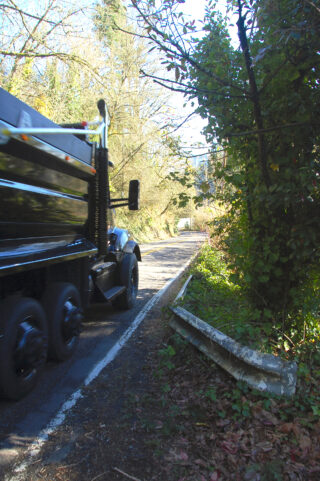
(Photos courtesy friend of the author)
Would you feel safe on this street?
__
Getting a sidewalk built, or even a path on the side of the road, is too often a herculean effort, one that is becoming increasingly relevant now that the Residential Infill Project (RIP), which will hasten more development, has gone into full effect. The city’s historic strategy of relying on development to provide sidewalks and bike lanes is not working for southwest Portland—and maybe not for other areas too—but as the Southwest Correspondent I’ll stick to the streets I know best.
The Portland sidewalk spiel goes something like this. In the beginning, there was the Annexation by Decade map (below). It explains a lot. The original development of the central city included sidewalks, and many of those old sidewalks are still in place. The 100 year old sidewalk on my street has held up really well, although a few years ago the city made property owners fix the cracks, per city code 17.28.020:
The owner(s) of land abutting any street in the City shall be responsible for constructing, reconstructing, maintaining and repairing the sidewalks, curbs, driveways and parking strips abutting or immediately adjacent to said land…
Advertisement
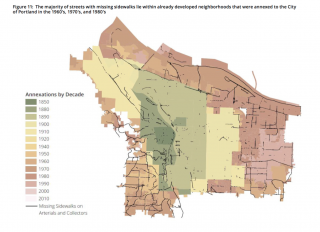
In the mid-20th century, Portland began annexing parts of unincorporated Multnomah County, mainly in what are now southwest and east Portland. The County didn’t have a sidewalk requirement, so those areas joined the city sidewalk-less, and they lack complete networks even today. However, any new development or substantial expansion is required to build sidewalks per the city ordinance above. That is why you can find patches of sidewalks, or “sidewalks to nowhere” in places. Eventually, with enough new development, and with various City infill projects, these areas will arrive at a more complete network.
That is the simple Portland sidewalk story.
Things get more complicated when you take stormwater management requirements into account. As the Streets 2035 report showed, on the westside stormwater drains into streams (with the exception of downtown). This means that new cement sidewalks can’t comply with federal EPA standards unless they treat the stormwater, like what the city is doing on SW Capitol Highway—at a cost of $27.5 million for one mile of bicycle and pedestrian facilities.
That stormwater expense is the reason that the city often doesn’t require new construction in the southwest to build cement sidewalks. The sidewalk requirement gets reduced to a 6 ft shoulder on the side of the road, but I’ve seen it go down to 3 ft if the ROW is constrained.
The city has ordinances which require new development to meet minimum transportation standards in order to be approved, including (at least prior to 2018) a “safety for all modes” clause (that’s where improvements for walking and riding a bike come in). In an region with the the narrowest ROW in the city, however, developers struggled to meet the “safety for all modes” requirement. That might be why in 2018 the city watered-down the transportation requirements to say:
Evaluation factors may be balanced; a finding of failure in one or more factors may be acceptable if the failure is not a result of the proposed development
That’s a pretty big loophole for a policy that is intended to provide infrastructure to a region with glaring deficiencies. Because the requirements can be mitigated, or modified in an “Alternative Review,” the process becomes subjective, with the result that neighbors or neighborhood associations appeal the approvals, and those appeals end up before the City Council, the state Land Use Board of Appeals, or eventually the state courts. In these land use cases you will hear legal jargon like “nexus” and “proportionality,” or of “Nollan/Dolan” rulings which limit and proscribe the improvements a municipality can exact from a developer.
In a nutshell, I interpret Nollan/Dolan as meaning that you can require a development to ice a cake, but you can’t make them bake it. Southwest Portland is an unbaked cake. Nollan/Dolan and lack of stormwater infrastructure make it difficult for the city to enforce the frontage improvements required by code.
Building a sidewalk doesn’t seem so simple anymore!
Out of frustration and impatience with unsafe streets someone like Michael Reiss considers painting his own advisory shoulders, or Don Baack grabs a shovel and builds nearly 50 miles of trails, or a friend of mine spends the summer bushwhacking paths in Portland Heights.
Let’s look a little more closely at one of my friend’s bushwacking projects. He cleared the weeds in back of a guardrail to make a path on a city-owned width of land near the bottom of SW Broadway Drive. The location is the densest area of Portland Heights, with several apartment buildings, a condominium complex, and houses rented out to groups of students. A new 20-unit townhouse project was approved for development last year. Yet for all this density, the city has not exacted enough from developers to provide residents with a connected place to walk. Lower Broadway still only has patches of sidewalk and the residents, many of them renters, cannot safely walk downtown to where they work and go to school.
My friend decided to do something about it. The city engineer was so impressed with his work, and the urgent need for safety improvements, that she had the last segment of guardrail removed so that people didn’t have to climb over it to reach his path. With his volunteer work and the cooperation of the city, folks now use his path and are a little more protected on their way downtown.
This isn’t a rural environment. It’s a couple hundred yards from where the 6th and 4th Avenue protected bikeways are going in. It’s across I-405 from PSU. It’s near where the southwest corridor lightrail was to fly over 405 into downtown.
Southwest Portland is not getting sidewalks. Grassroots efforts like SWTrails and my friend’s bushwhacking might point a way to a solution, the city should support their work. Making it easier to become indemnified would help.
The questions are 1), how will the city make streets safe for all users on roads too narrow for bicycle and pedestrian facilities? 2) how much car-dependent development will the city continue to allow in neighborhoods lacking active transportation facilities or adequate public transportation?
Disclosure: I was involved in preparing a Broadway Drive Land Use case before the City Council and the Land Use Board of Appeals.

— Lisa Caballero, lisacaballero853@gmail.com
— Get our headlines delivered to your inbox.
— Support this independent community media outlet with a one-time contribution or monthly subscription.



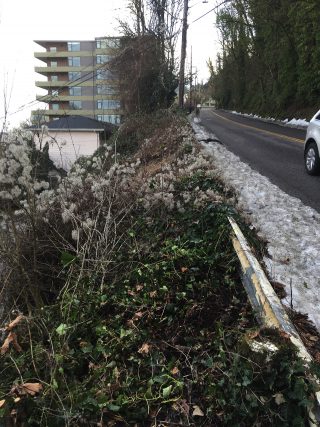

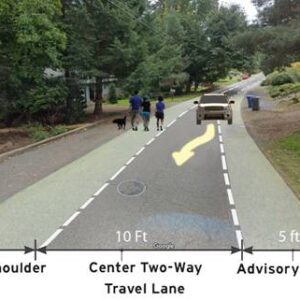
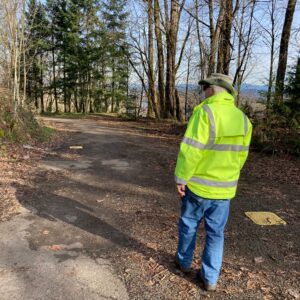
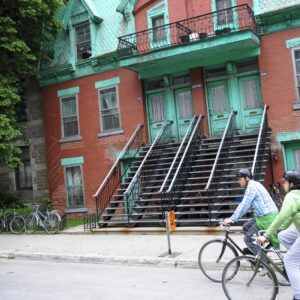

Thanks for reading.
BikePortland has served this community with independent community journalism since 2005. We rely on subscriptions from readers like you to survive. Your financial support is vital in keeping this valuable resource alive and well.
Please subscribe today to strengthen and expand our work.
A reader just sent me a link to an excellent article she wrote on the Nollan/Dolan court cases:
https://cedarmillnews.com/legacy/616/nollan.html
One of the effects of these two Supreme Court decisions is that Development Review, planners and BDS have to do their jobs with an eye on these rulings. They are in the stressful position of threading a needle between two possible complainants–neighbors ticked off that the city isn’t enforcing their code, and developers who threatened to bring a 4th amendment takings case.
that stormwater expense needs gone, complete woke nonsense. or is such more important than keeping people from under the truck. ? well ?
right now, make a decision and dont compromise for woke nonsense. aka totalitarian tiptoe. portland is its matrix, grow up… please.
rain waters
Your claim, ignores the destructive potential of flowing water and the generous pollution left by cars. Ranting about these as “ nonsense “ verifies that you really have not given the issue much thought and really didn’t grok the fullnes of Lisa’s post.
Water pollution is fake news.
My interpretation of the City’s 2020 Stormwater Management Manual (SWMM):
1.8 Special Circumstances
1.8.1 Staff-Review Special Circumstances
1. Create, expand, or replace sidewalk and other pavement in the sidewalk corridor behind an existing curb in the right-of-way;
2. Create, expand, or replace pedestrian paths or walkways that connect be otherwise managed; or
3. Add or replace impervious area to meet Americans with Disabilities Act (ADA) requirements.
For projects that meet the above criteria, the Offsite Stormwater Management Fee will be allowed through a Staff Review Special Circumstances for the qualifying areas.
My take is that stormwater should no longer be an “excuse” not to build sidewalks. I confident that an in-lieu fee would be a much lower cost than what it would actually take to provide public stormwater facilities.
I don’t know exactly what the EPA requirement is, but it would supersede any local code.
I think the original author on the SW Corridor article may be construing ‘treatment’ with ‘impoundment’. There’s no treatment being performed in an open basin. It’s impoundment/infiltration, aka a bioswale. Nothing new.
Hi John, the Cap Hwy project website refers to the basins as “treatment and detention.” I assume that phrase came from BES. I’m also curious what the treatment is, but the info isn’t available without more investigating than I want to do. Maybe a bioswale is considered treatment.
Thank you for the article and for helping Jonathan build up the blog.
Treatment in water quality facilities is dealing with pollutants, volume and velocity. Pollutants are broken down by soil microorganisms, captured on the vegetation and actually taken up by plants. Soils blended with sand and compost has good soil biology and lots of pore space for the little Pac Men to do their work. Roads collect storm water and discharge it in short duration, high velocity and volume events that scour and damage natural water courses. Basins stop the velocity and diminish the volume by releasing water slowly. Basins can combine with treatment and sheet flow off roads can be infiltrated and treated with bands of good soil and dense vegetation So, you are right, bioswale is treatment and so are “bioslopes” and created and natural wetlands
Just FYI although the property owner is responsible for sidewalk maintenance the city is generally responsible for curbs (with a few minor exceptions)
https://www.portland.gov/code/17/28#toc–17-28-020-responsibility-for-sidewalks-and-curbs-
I’m impressed you’ve decided to take this on.
This is such a difficult and complex subject in any jurisdiction, so none of us should be surprised that there’s a bunch of gaps in your report even in SW. I’d suggest you read the PBOT 2019 PedPDX report a bit more thoroughly (pdf): https://efiles.portlandoregon.gov/record/13065504/file/document. There’s a good history section starting on page 51. There’s also a good summary map on page 13. Pleasant Valley in far SE Portland has many of the same drainage issues as SW.
Multnomah County and ODOT have also historically built some sidewalks before the city annexed various areas, and ODOT is now building sidewalks on outer Powell and soon on 82nd, as has PBOT along 102nd, 122nd, 162nd, etc. Both Portland and Multnomah County did not require sidewalks until the 1980s, so even in the urban parts of Portland proper there were always huge gaps, as you rightly point out on SW Broadway. Multnomah County did require sidewalks along arterial roads later on, but like Portland, they didn’t always enforce the law. There are large areas within East Portland with excellent sidewalk connectivity thanks to certain enlightened 1950s suburban developers just as there are huge sidewalk gaps in the inner long-ago annexed poorer parts of SE, NE, and NoPo. The City of Portland has a long history of being consistently inconsistent in its sidewalk building, maintenance, and enforcement policies, not unlike every other jurisdiction, particularly regarding sidewalks in poor areas, at public schools and at city parks.
Great report!
I recall reading a few years ago about something called a “waiver of remonstrance” which is basically the City saying new developments don’t have to build new sidewalks if they don’t connect to anything on either end. The requirement is still tied to the property and transfers with the deed, but is toothless unless the City decides to one day make good on it.
If I recall the article correctly, there have been over 10,000 such waivers issued since the 1980s. That’s a helluva lot of isolated segments. I wonder what it would look like if you mapped them out? I’m sure there’s a record of them all in a filing cabinet somewhere.
I once did see such a map 8-10 years ago, when there were “only” 7,000 waivers. Either PBOT or BPS made the map. The waivers were all over town – anyone could get them by petitioning any city councilor, and many did – but the greatest concentrations were in SW and East Portland, of course. I have no idea where that map is. If I have a copy of it, I’ll forward it to JM.
Like here ? https://pamplinmedia.com/pt/9-news/224997-86058-where-the-sidewalk-floats
That filing cabinet is probably in a dark corner of some dusty basement.
Lisa, thank you for writing this. I lived in SW for years, and felt like a second class citizen when I walked out my door. So many people seem to think that it’s just East Portland that desperately needs more and better infrastructure.
I grew up in SW Portland; Multnomah to be precise, actually on an unpaved section of SW Hume Street between 35th and 37th. My folks bought their house in 1948; it had a septic system. My mother actively worked for annexation in order to get sewers, which finally came in the 70’s, I think (I was pretty much gone by then!) The house across the street had a sidewalk in front. That was it…a short ride on my trike! Even after sewers our basement regularly flooded as the house sits lower than the street.
So our unpaved street, full of pot holes, was used by all modes; potholes were occasionally filled by residents with mixed results; speeding vehicles were few; our dog like to hang out in a pot hole and wait for a car to chase…he was a real addict.
I started riding a bike at about age 6; bikes became my primary means of getting around SW (Hillsdale, Wilson HS, Lewis & Clark College) until I was 16 (I even rode one to N. California and back and up to Vancouver BC via the Olympic Peninsula). We walked to “The Village” via 36th…an unpaved track or via the rudimentary paths along 35th. A “lawned” section of 36th at Hume was our softball/touch football field. Mom said “its public ROW!”
The dangerous streets were the paved ones when traffic was at times heavy and often fast. Not much has changed, and many people seem to like the informal, rural feel of Multnomah.
What’s the Dutch word for mixed mode streets with uneven surfaces? That’s what our street was and still is, and it worked pretty well for us and probably still does.
SW 37th was paved with an LID, no sidewalks, more run off, faster traffic, and my folks said why would we do this? Just drive slowly, watch out for ‘God’s own speed bumps,” and everything is fine!
You’re probably thinking of “Woonerf”?
Thank you for the SW Portland reports. My neck of the woods. I often see people walking on the practically non-existent shoulder of SW Shattuck–scary–where I ride on my way to Beaverton-Hillsdale Highway (BHH) as part of my commute. With the new speed bumps, cars weave back and forth to position their tires in the gaps to avoid the bump. This makes walking and riding on Shattuck even more perilous. While we’re on the subject of SW Portland, I’d really like to see Scholls Ferry between BHH and Sylvan reduced to a two-lane road. Currently there are two uphill lanes and one downhill. The two uphill lanes encourage drivers to speed like crazy–it’s a race! One lane in each direction would slow everything down, and create room for two decent size shoulders. It is possible now to ride downhill on Scholls–you can basically keep up with traffic–but not uphill. You’d get creamed on a blind curve.
That section of Scholls Ferry is vying for the title of worst road in the entire metro area for active transportation. One of the only roads that I would absolutely never even consider walking or biking on, and I consider myself pretty confident. And there seems to be zero appetite to do anything about it, despite it being such a vital link with no feasible alternate routes.
There’s such an easy, intuitive fix: take out one uphill lane and add a two-way cycletrack and walking space (preferably on the west side of the road to avoid the Patton/Hamilton/Humphrey crossings). But for some reason MultCo (the owner of this section of the road) refuses to do so.
Multnomah County owns the treacherous part of SW Scholls Ferry Road and that ownership starts from SW Raleighwood Lane to ODOT’s freeway overpass over Highway 26 and then I assume PBOT owns (and neglects Skyline Blvd) until out in unincorporated Multnomah County where the potholes mostly start to fade away. Metal-studded car tires. West Burnside is wild but it does have shoulders in certain parts and TriMet bus 20 for all of it yet Scholls Ferry Road has only one bus, the 55 on weekdays, and Scholls has a retaining wall as a rock climbing shoulder. I’ve walked and rode a bike on Scholls from at least Whitford Elementary school to Skyline just passed the original Pizzacato store. I’ve also rode a bike on all of “Skyline Boulevard” and all of Scholls Ferry Road that has that name including Old Scholls in Raleigh Hills. Scholls will get a new sidewalk on the north side of it between 77th Avenue and SW Laurelwood Ave by late 2022 and it is the first, new sidewalk on any Scholls or Skyline since around 2016 when WashCo built some in the Whitford neighborhood.
And the 55 only runs from BHH to Hamilton; there’s no bus at all the rest of the way to Sylvan. Plus absolutely zero shoulder in most parts. Really, unless you have a car there’s no way to use the road. The WashCo section from Raleighwood Lane to BHH is significantly better than the MultCo section; at least it has walkable paved or grassy shoulders plus the bus route, and the center turn lane allows impatient drivers to pass while leaving enough space rather than way too closely.
Really, I think MultCo is the worst of all of the region’s transportation providers for active transportation that I have experience with (comparing to WashCo, PBOT, ODOT, and Beaverton). Name one road of theirs with even serviceable infrastructure; I can’t even think of a single one.
MultCo is actually adding a car lane on 238th by Fairview and Gresham yet they likely have not repaved Scholls since the 1990s. They claim that they don’t get income for streets from new housing being built in unincorporated MultCo unlike incorporated WashCo’s development income source. That part of Scholls is the worst of any around the metro area. I’ve even rode a bike on Cornelius Pass Road going north from Skyline. Sometimes, a person can wait for a person driving a slower farm tractor in order to just ride a bike going north and just ride in front of that person in the tractor. I meant to say that I’ve rode a bike all of Scholls from the cafe at the stop sign in the farm land and then onto Skyline in both directions. I’ve rode a bike going uphill from BHH in the snow.
A street buffet “road diet” would be amazing on that part of Scholls. Multnomah County owns it from SW Raleighwood Lane to likely ODOT’s Highway 26 overpass. That county judges needs based on equity and racial factors so it has a low score despite the return on investment and neighbor relations that it could vastly make with Washington County which owns all of it where Scholls enters their boundary. Imagine if ODOT built a wider shoulder in eastbound Highway 26 from about the county boundary to SW Jefferson so that TriMet bus 58 and a rerouted bus 56 could skip eastbound gridlock (after Oregon state law gets changed like Washington has for freeway shoulders for public transit) ? I’d love a boardwalk on the westside of Scholls and then a shared sidewalk on the east side. Then make a high and raised cycle track on the westside near SW Thomas Street on Scholls.
If you want sidewalks in your neighborhood check out this link. The main vehicle is through a LID (local improvement district)
https://www.portlandoregon.gov/transportation/72581
What options do I have to build sidewalks in my neighborhood?
If you wish to voluntarily repair or construct sidewalk in front of your property, you can apply online for a Voluntary Minor Improvement Permit. For more information about this option, you can call 503-823-7002 option 3 or email PBOTsidewalkpermit@portlandoregon.gov.
Another common option for constructing sidewalks is to form a Local Improvement District (LID). A Local Improvement District is a method by which a group of property owners can share in the cost of infrastructure improvements, most commonly for transportation and stormwater. This can involve improving the street, building sidewalks, and installing a stormwater management system. An LID can also be used to install sidewalks on existing streets that previously have been accepted for maintenance by the City. For more information about LID’s, you can contact Andrew Aebi at 503-823-5648 or andrew.aebi@portlandoregon.gov.
LIDs work for small projects; and even if costs were affordable to the 100 or so tax lot owners along the 1+ mile road, the BES runoff rules mean you likely can’t get a sidewalk the whole length… perhaps a portion, tho BES doesn’t seem to know how much sidewalk runoff the local infrastructure COULD take.
“This means that new cement sidewalks can’t comply with federal EPA standards unless they treat the stormwater”
Why cant they propose to meet the requirement by using a pervious pavement option. Pervious pavements can act as filters for the pollutants that run off the roadway. You don’t need to convince the EPA, they are already a fan….”permeable pavements can help filter out pollutants that contribute to water pollution”. The ground in Portland during the rainy season is often already saturated so more water just runs off the top. Pervious pavements also slow down the water compared to saturated ground, and give it more time to absorb.
https://www.epa.gov/soakuptherain/soak-rain-permeable-pavement
Development of all kinds in hilly areas is often found to have some impact on the watershed, but this is often dealt with by the process of mitigation. This mitigation is often at a completely different location sometimes many miles away in a different watershed. Then why can’t they propose something like the already existing Bioswale projects as mitigation for the sidewalk impacts. Since the pollutants primarily come from cars, mostly carbon black, they could also propose using VMT reduction as a mitigation strategy, by say for example, installing sidewalks to offer an alternative to driving.
Permeable sidewalks work as long as the underlying soil is also permeable, and in most of Portland it is. But it’s not the case in most of SW and outer SE in Pleasant Valley, where the soils either have too much clay or too much bedrock, and hence the need for larger-than-usual bioswales and retention ponds. On your second point about mitigation, moving water many miles to an external location is not only very expensive, but it only works if there is a lot of extra land around to move it to, and that the land is also cheap. Unfortunately that sort of mitigation has already been maximized in SW – there are no more cheap lands left, somebody owns each and every “empty” parcel, some of which are apparently still being used as septic fields. Your third point about VMT reduction tends to be a challenge that PBOT so far has only tried in very high-density parts of the city, with very mixed results.
David – I also used to believe that permeable sidewalks only work as long as the underlying soil is also permeable but the good folks at the City of Gresham have disproved this common misconception:
http://oregonewrg.org/wp-content/uploads/2018/12/Pavement-That-Can-Clean-Water.pdf
Not only does pervious asphalt with a compacted gravel (impermeable) layer provide WQ benefits, but it also less noisy and more important for the bike community produces a significant less amount of spray when raining/wet. This finding leads me to believe that all multiuse paths should use pervious asphalt.
*Although there is tendency of moss build-up on these surfaces that could become more slippery if not managed*
Pervious concrete on the other, I am skeptical of its widespread use for other reasons. This product is much more trickery to install and appears to be more brittle and as a result have shorter longevity – definitely probably wouldn’t last 100-years. There is a section of a pervious concrete sidewalk that I helped design for the City along NE 72nd Avenue north of Killingsworth, leading to Cully Park. Go check it out and judge for yourself.
To reiterate my initial point, stormwater management shouldn’t be as much of a deterrent in the implementation of infill sidewalks. Especially given the recent ADA lawsuit against ODOT
https://adatile.com/landmark-lawsuit-oregon-department-of-transportation-ada-settlement/
The City has created a fee in-lieu option when when constructing/rebuilding new sidewalks. This money would go towards treating stormwater potentially more effectively at a different (potentially downstream) site within the City – so we are good with EPA. In my experience, the fee in-lieu approach ends up being much less expensive than having to build facilities at the site. I feel like it’s something like $3.50 per square foot of impervious area.
A “hot button” issue indeed.
Outer East Portland is similar to SW Portland in that we have a number of arterials and collectors with no sidewalks. Many of our arterials still have no contiguous sidewalks, but the area is zoned similar to most of the inner southeast and northeast and we have more residential infill than any other area of Portland. This is an important distinction to recognize. The city has funded many sidewalk projects and complete street improvements in East Portland, and we’re just now starting to see these projects being built through the East Portland In Motion plan.
Regarding storm water management, most of East Portland has on site storm water management systems, but we’re paying outrageous on-site and off-site storm water management fees to fix the inner city’s drainage of storm water into the sewer system. Big Pipe project and Green Streets projects come to mind, so we’re paying to fix the inner city’s problems. I’m ok with that, but folks that live in the inner city complain about building sidewalks and think property owners should pay for the sidewalks. I think properties with no on-site storm water management should pay for the upgrades to correct their storm water issues, or ease up on building sidewalks on arterials and collectors in other areas of Portland.
Thank you for taking the time to write this, Curly. Comparing the “Annexations by Decade” map, with the Streets 2035 map shows that the neighborhoods which handle their stormwater through “Combined Sewer Overflow” (Big Pipe, $1.4 billion to build) overlap pretty well with the core Portland neighborhoods which have the city’s original sidewalks. We all pay for the Big Pipe. “Big Pipe”is a good two-word response to anyone who thinks they paid for their old sidewalks.
Lisa,
“Police costs” is a 2 word response to your contention. Why should relatively calm inner and west Portland have to pay police costs for relatively lawless East Portland? Let’s spin off “east of 82” from the city and let them fend for themselves.
A Multomah County audit on property taxes found that East Portland was paying far above its share of property taxes versus what it was getting from the city, so the City of Portland has an awful choice: They can either be bullied by the feds into improving East Portland (the current status quo) or commit double suicide and let East Portland incorporate as a separate city. (It would be double suicide since the city would be both deprived of East Portland’s huge tax revenues that have largely paid for rebuilding downtown, AND the city would be forced to pay billions in back taxes owed to East Portland, likely losing most city assets in the process including the Bull Run water supply. The city could even face Chapter 9 bankruptcy and find itself as an unincorporated area of Multnomah County – now wouldn’t that be ironic?)
Thank you Lisa Caballero for this insight into Non-Motorized Transport / Mobility in Portland.
A very significant factor in the sidewalk issue is that they are the responsibility of the adjacent property owner to initially put them in and maintain them, eg. repair cracks, etc. Yet, if the roadway adjacent to the property needs repair the government jurisdiction repairs it using funds that the public pays into : Federal, State, County, City taxes and fees. Until the sidewalks in Oregon are made the responsibility, for construction and maintenance, of the jurisdiction that controls the adjacent private and public property then sidewalks will alway be the poor stepchild to roadways. Sidewalks are public infrastructure just as important as roadways, and are just as used by the public as are the roadways. The sidewalks are within the Public Right-of-Way just as the roadways are. If a utility needs to access your property, they must secure a permanent or temporary easement, no such “easement” is required for the roadway or sidewalks. Yet, if the heavy vehicles servicing the utilities — sewer, water, gas, electric, tele-communications damage the sidewalk and roadway, the property owner is liable for the repair to the sidewalk. You can attempt to have the utility pay for fixing the sidewalk, good luck if you did not see which heavy vehicle from which utility ( or their sub-contractor ) did the damage. You as the property owner are still liable. Until this huge gap in responsibility for sidewalks in Oregon land use law is corrected, the problem will continue.
I’ve thought about this a lot too. I don’t understand why the roadways are public responsibility and sidewalks are not in Portland, and in a lot of cities in the U.S. Both serve the public, and sidewalks are equally important infrastructure elements as roads. I don’t understand why property owners in the US pay for sidewalks that are in front of their property on public land , as if they are paying for some kind of convenience that only this one property owner will exclusively use. Anyone walking on the street will use the sidewalk, just like everyone driving down the street will use the road. Coming from a European country, this just seems extremely strange and illogical to me.
It does seem extremely strange and illogical.
Thank you for this.
Washington county theoretically tends to follow this approach too. Unfortunately they’re not actually doing it. There’s a big development happening in the heart of Cedar Mill that was supposed to fill in a nasty bike lane gap on Cornell as a requirement of the project. When I saw the street get restriped without the bike lane I contacted WashCo Roads to find out what was going on. They said that the road wasn’t where they thought it was so there’s no longer space to put it in and it won’t happen. That stretch of road hasn’t changed in decades. Talk about the single most ridiculous excuse I have heard in my life.
Policies of waiting on development are questionable at the best of times, but when they claim that as a policy then don’t even follow through with enforcement it becomes actively harmful. We’ve been advocating for decades to get this gap fixed, always to hear the development line. Well it finally happened, it was in the plans, and now they’re not going to put it in. So how exactly are citizens supposed to get safety improvements? This is a big problem.
What about where there shouldn’t be a sidewalk. It would be to nowhere, orphan sidewalk, create runoff and ruin the rural feel of the neighborhood?